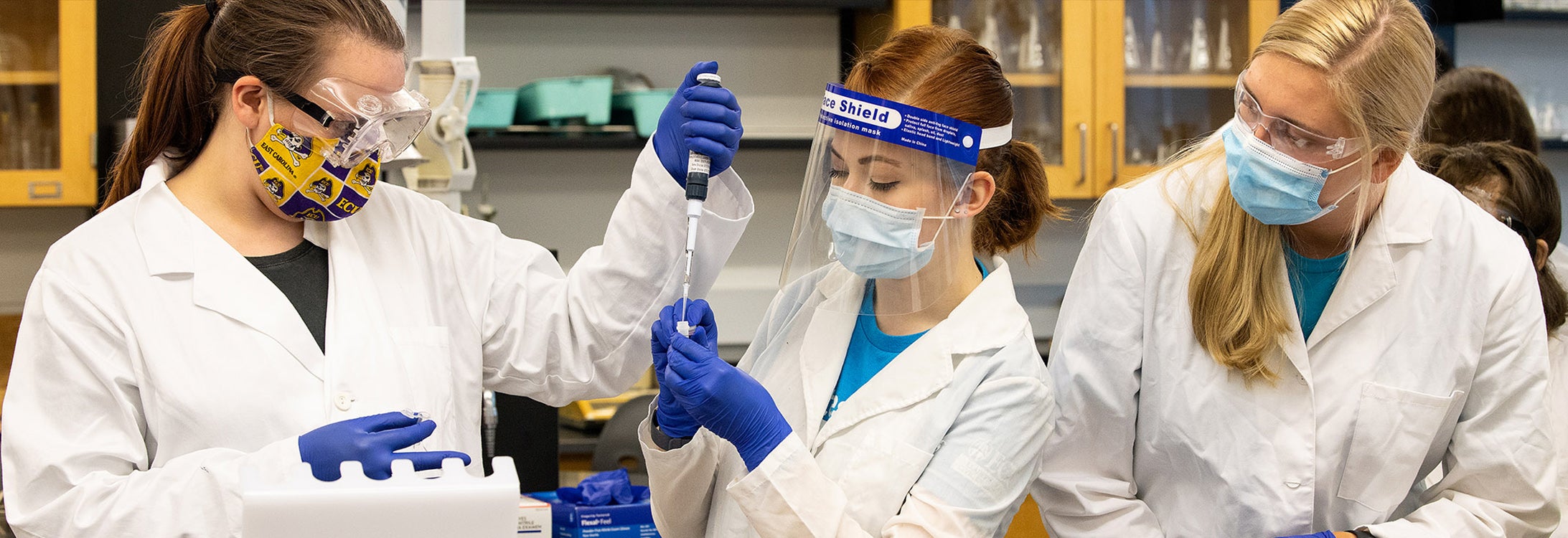Course-based Undergraduate Research Experiences (CUREs) at ECU
Undergraduate research is a high-impact practice that has been shown to enhance student learning and engagement. Because research is so impactful, we want as many of our students as possible to experience it! That’s where our Course-based Undergraduate Research Experiences come in. Our CUREs bring research into the classroom, allowing students to experience being a part of a project during their time in class. Our CUREs are curriculum based, so students can easily enroll in these courses with an emphasis on research as part of their regular course of study. Many of our CUREs at ECU have the added benefit of being part of a current grant project supporting team science, so our future leaders in STEM learn to work together to solve our region’s biggest challenges. In the future, look for courses with the RI (research intensive) designation in your catalog for available CUREs. Fill out our CUREs Interest Form to receive more information. Learn more about CURES online.
Current Pre-CUREs
The following introductory lab courses engage students in experimental design, data collection and analysis, scientific argument construction, and scientific writing. All of these skills plus learning to work as part of team prepare students to move into research.
- General Chemistry Lab I/II (CHEM 1151/1161)
- Principles of Biology Lab I/II (BIOL 1101/1201)
- General Physics Lab I/II (PHYS 1251/1261)
- Dynamic Earth Lab (GEOL 1501)
Current CUREs
Microbiology Lab (BIOL 3221), Ariane Peralta
Since 2003, replicated fertilization and disturbance (by mowing) treatments have been applied to a nutrient-poor wetland ecosystem at East Carolina University’s West Research Campus. While the wetland plant community is surveyed annually in the Vegetation Sampling and Analysis CURE (BIOL 3550), wetland soils are also sampled annually, and soil microbial analyses are conducted in BIOL 3221. Students in BIOL 3221 culture wetland soil bacteria and characterize these bacterial isolates. In this mini-CURE (approx. 4 weeks), students measure bacterial traits including morphology, carbon metabolism, nutrient acquisition, and antibiotic resistance; and each bacterial isolate is identified to the species level by Sanger sequencing the full length 16S rRNA gene. Students work in teams to evaluate results to examine how ongoing environmental changes influence wetland soil bacteria. For more information, click here.
Microbiome Sequencing and Analysis (BIOL 3504, Section 281), Ariane Peralta
This additional laboratory section leverages environmental and bacterial community composition data from the long-term wetland ecology experiment at ECU’s West Research Campus. In this semester-long Microbiome Sequencing and Analysis CURE, students:
- describe how complex microbial communities (i.e., microbiomes) are examined using culture-independent sequencing
- employ practical computing and bioinformatics code to process bacterial sequences
- analyze environmental and microbial data using modern statistical approaches
- communicate science using digital literacy tools (e.g., Adobe InDesign)
For more information, click here.
Vegetation Sampling and Analysis (BIO 3550), Carol Goodwillie
The course involves undergraduates in a long-term, large-scale experiment in plant community ecology. Students gain skills in plant identification, vegetation sampling methods, statistical analysis of large data sets, and scientific communication. Working in teams, students collect plant community data at a local field site, analyze the data to test their hypotheses, and present their results in written and oral formats.
Marine Biology Lab (BIOL 3661), Rebecca Asch
The goal of this CURE is to examine the distribution of microplastic pollution and its impacts on coastal organisms in estuaries with contrasting amounts of urbanization. Students participate in three one-day research cruises where they collect water quality samples and samples of mesozooplankton, benthic macrofauna, and demersal fishes. Organisms are enumerated and identified to higher taxonomic levels during subsequent labs, while water quality samples are analyzed in the ECU Environmental Research Laboratory (ERL). Also, students learn how to operate a ZooScan, a novel instrument that uses machine-learning algorithms to semi-automatically identify zooplankton taxa. Fishes are dissected and their stomach contents are inspected to assess ingestion rates of microplastics.
Microbial Biotechnology (BIOL 4420), Erin Field
This course focuses on the microbial role in environmental, agricultural, and industrial processes with emphasis on how microbes function and what we can do to control or enhance their capabilities. Topics covered include water treatment, biofuels, environmental remediation, food production, and pharmaceutical development. The associated lab will provide hands-on experience and the opportunity to use cutting-edge sequencing technologies to conduct a course-based undergraduate research project.
Microbial Ecology (BIOL 4560), Ariane Peralta
Students in the interdisciplinary wetland CURE will study how hydrology and nutrient addition interact to influence plant-soil-microbial interactions. Students will examine how hydrology and nutrient enrichment directly and indirectly (via plant effects) affect wetland microbial structure-function relationships.
Applications in Molecular Cell Biology (BIOL 4800), Elizabeth Ables
This course provides upper-level Biology students an immersive research experience in which to gain practical skills in genetics and molecular cell biology.
Organic Chemistry II Lab (CHEM 2753/CHEM 2763), Robert Hughes
In this project, students will work with protein biocatalysts that catalyze carbon-carbon bond forming reactions in non-aqueous or mixed aqueous/organic solvents. Students will screen these proteins for their ability to catalyze the synthesis of important pharmaceutical compounds, such as warfarin (an anticoagulant) and Bis-4-hydroxycoumarin (an anti-cancer compound). Students will quantify reaction yields and enantioselectivities and perform optimization studies. Biological activity of the compounds will be evaluated in cell-based assays.
Quantitative and Instrumental Analysis (CHEM 3251), Eli Hvastkovs
The CURE lab will seek to develop a disposable paper-based microfluidic device that can perform the basics of a titration (analyte concentration determination, colorimetric detection) using minute amounts of consumables. The microfluidic devices will be constructed of paper and wax and will be able to be used to determine the concentrations of a variety of analytes based on the choices by the student groups. Several different designs will be explored, but we will start with a parafilm-kimwipe version summarized in literature that features the detection of iron and copper in water with colorimetric detection, which can be visualized using a common smartphone.
Inorganic Chemistry Lab (CHEM 3451), Sambuddha Banerjee
In this course, students will learn rational syntheses of hydrazone ligands that can preferentially bind to biologically relevant transition metal ions and assess antimicrobial/anticancer properties of the synthesized ligands and metal complexes in reference to known active drugs. In line with the core CURE principles, ligands synthesized by each team will have different electronic and steric effects that can potentially alter their coordination property as well as biochemical activities. As a WI course, students in this CURE class will also get exposed to different types of scientific writing methods (journal articles as well as scientific journalism) and will be required to produce their original final report based on their research in one of these two styles. Students completing this CURE inorganic class will be expected to design and execute organic ligand and metal complex synthesis, characterization using established methods (NMR, UV-Vis., Fluorescence, IR, CV, CD, etc.), rationalize spectroscopic results using group theory, perform assays to determine IC50 values, and present their research work to a disciplinary and non-disciplinary STEM audience.
Biological Chemistry Lab (CHEM 3771), Adam Offenbacher
This CURE aims to expose students to non-trivial quantum effects in nature, focusing on the lipoxygenase family of enzymes that oxidize fatty acids to potent signaling molecules. Students will express and purify a library of LOXs from different species using bacterial cultures, thereby gaining experience in protein isolation techniques. Students will examine the kinetic properties of the LOX library with UV spectroscopy and learn how to determine the reaction barriers for the oxidation reactions. This information will help to understand how nature has evolved proteins to harness quantum phenomena (hydrogen tunneling in the case of lipoxygenase) towards enzyme fitness.
Instrumental Analysis (CHEM 4351), Eli Hvastkovs
This course serves as a capstone in the chemistry curriculum, the content of the course centers on how to design and perform instrumental analyses for a variety of applications.
Water Quality (ENVE 3103) and Water and Wastewater Treatment (ENVE 3203), Natasha Bell
This two-semester CURE will enable teams of junior-level environmental engineering (EE) to apply learned concepts and actively participate in the research and engineering design processes to ultimately test the efficacy of designed treatment technologies for remediation of nonpoint source contaminants. Treatment technologies will be investigated at the laboratory- and mesocosm/pilot-scales and include constructed wetlands, subsurface bioreactors, and adsorbent filters.
Groundwater Hydrology (ENVE 4203), Randall Etheridge
This CURE investigates the groundwater flow, groundwater/surface water interaction, and contaminant transport in engineered and natural systems near campus. Students collect field samples for laboratory analysis and perform in situ field tests to better understand how the studied systems function.
Introduction to Field Methods (GEOL 3200/3201), Eric Horsman
Students collect their own observations about local geology, integrate them with published observations / literature, and complete a substantial final project that includes multiple geological maps, a scientific paper, and other products.
Introduction to Hydrogeology (GEOL 3500), Alex Manda
This CURE investigates the interactions between groundwater and surface water that impact the quality and sustainability of water resources. Several sites may be studied in this CURE, including research performed at Town Creek near ECU.
Sedimentology (GEOL 4010/4011), Catherine Rigsby
Students collect data on field trips to two modern sedimentary depositional environments. Additionally, samples collected on those trips are processed in the lab. Data is integrated with published observations / literature to produce a journal-style article, including student-produced maps/diagrams.
CUREs News & Notes
- TEAMS-UR Project: Team Experiences and Mentoring Strategies for Undergraduate Research
- Supporting Team Science: New $1.6M Grant Will Prepare Students with Skills Desired by Employers Through Research
- The Road to Discovery: Course-based Undergraduate Research Leads to Publication, Grant





